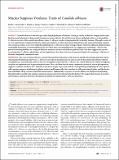Mucins Suppress Virulence Traits of Candida albicans
Author(s)
Kavanaugh, Nicole Lynn; Zhang, Angela Q.; Nobile, Clarissa J.; Johnson, Alexander D.; Ribbeck, Katharina
DownloadKavanaugh-2014-Mucins suppress viru.pdf (2.408Mb)
PUBLISHER_CC
Publisher with Creative Commons License
Creative Commons Attribution
Terms of use
Metadata
Show full item recordAbstract
Candida albicans is the most prevalent fungal pathogen of humans, causing a variety of diseases ranging from superficial mucosal infections to deep-seated systemic invasions. Mucus, the gel that coats all wet epithelial surfaces, accommodates C. albicans as part of the normal microbiota, where C. albicans resides asymptomatically in healthy humans. Through a series of in vitro experiments combined with gene expression analysis, we show that mucin biopolymers, the main gel-forming constituents of mucus, induce a new oval-shaped morphology in C. albicans in which a range of genes related to adhesion, filamentation, and biofilm formation are downregulated. We also show that corresponding traits are suppressed, rendering C. albicans impaired in forming biofilms on a range of different synthetic surfaces and human epithelial cells. Our data suggest that mucins can manipulate C. albicans physiology, and we hypothesize that they are key environmental signals for retaining C. albicans in the host-compatible, commensal state.
Date issued
2014-11Department
Massachusetts Institute of Technology. Department of Biological Engineering; Massachusetts Institute of Technology. Department of BiologyJournal
mBio
Publisher
American Society for Microbiology
Citation
Kavanaugh, Nicole L., Angela Q. Zhang, Clarissa J. Nobile, Alexander D. Johnson, and Katharina Ribbeck. “Mucins Suppress Virulence Traits of Candida Albicans.” mBio 5, no. 6 (October 28, 2014): e01911–14–e01911–14.
Version: Final published version
ISSN
2150-7511